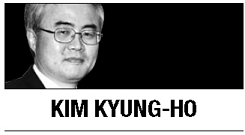North Korea’s attempt last week to shoot down balloons carrying anti-Pyongyang leaflets floated by South Korean activists heightened tensions on the peninsula with the effect of somewhat alleviating Seoul’s stance.
Seen from the substantial, not superficial, viewpoint, this act can be seen as vivid proof of the capitalist South’s victory over the communist North in the competition that followed the Korean War.
 The North had repeatedly threatened to fire on the sites where leaflets were launched, but those threats had not been followed by action until last Friday, when its frontline forces fired antiaircraft machine guns at the balloons.
The North had repeatedly threatened to fire on the sites where leaflets were launched, but those threats had not been followed by action until last Friday, when its frontline forces fired antiaircraft machine guns at the balloons.
The use of antiaircraft guns, which invited return fire from South Korean troops, seemed carefully calculated to rattle those in the South without causing too grave consequences by directly targeting the site of the launches.
It might have been partly motivated to gain the upper hand in the lead-up to the high-level talks both sides are planning to hold in early November at the latest, as agreed during a surprise visit by a group of senior North Korean officials here on Oct. 4. But it mainly shows that the North’s patience with the leaflets critical of its oppressive regime has worn out.
In other words, its use of antiaircraft guns may suggest that the propaganda leaflets from the South have seriously influenced North Korean residents to the point of pushing Pyongyang to make extreme efforts to block them.
Ironically, the North has virtually suspended sending its own leaflets into the South. Its frontline units have sporadically scattered leaflets, but in a negligible amount.
No one here believes Pyongyang is refraining from sending its propaganda leaflets to avoid harming inter-Korean relations. Even left-leaning figures sympathetic with the North would feel it insensible to make such an argument. In fact, North Korea’s state propaganda machine has ceaselessly issued statements pouring all kinds of vitriol on conservative South Korean leaders.
It is evident that Pyongyang’s propagandists have judged that sending leaflets into the South would serve no purpose. It certainly does not require much intellect to imagine how ordinary South Koreans, especially those born after the South achieved its remarkable economic growth, would respond to the North’s shoddy leaflets full of vulgar words. In this sense, it seems sensible to reason that the tough statements from Pyongyang’s propaganda machine are targeted at North Korean residents rather than South Korean citizens.
Many older South Koreans, who went to primary and secondary school in the decades from the end of the 1950-53 fratricidal war through the early 1980s, remember being told by their teachers to immediately deliver any North Korean leaflets they found to nearby police stations without reading them. For them, the disappearance of North Korea’s propaganda leaflets overlapped with South Korean society finally establishing a democratic political system after decades of economic development and pro-democracy campaigning.
It was no wonder that Pyongyang was more active in agreeing with the previous liberal government in Seoul in the early 2000s to stop slandering each other.
It was civic activists and North Korean defectors here that began sending leaflets across the border after the North’s deadly naval attack killed 46 South Korean sailors in 2010. The leaflets’ sharp criticism of the harsh oppression by hereditary dictators seems to be unnerving the regime’s apparatus to the extreme degree. North Korea’s young ruler Kim Jong-un, a grandson of its founding leader Kim Il-sung, may be reacting more sensitively and indignantly to the leaflet campaign.
North Korea’s main newspaper, the Rodong Sinmun, this week described the scattering of leaflets as the “worst obstacle” to improving inter-Korean ties. This claim may be reinterpreted as suggesting that the leaflets from the South are posing the most severe threat to the isolated and impoverished regime.
Some cautious experts here express skepticism about the effect of sending leaflets, noting only a small portion of them actually make it across the border due to unfavorable wind conditions and that most land in areas not far from the inter-Korean border. But it still sounds persuasive to argue that it is all the more necessary to convey correct information to residents in the southern part of the North, as they are left less informed than people in the areas bordering China.
As part of efforts to keep the momentum toward resuming inter-Korean talks, the South Korean government is likely to put more pressure on civic activists and defectors to refrain from flying leaflets into the North. But it is beyond their legal authority to forcibly prevent them from doing so. And this certainly distinguishes the South’s free democratic system from the North’s suppressive totalitarian regime.
At this juncture in inter-Korean relations, however, activists and defectors here are advised to show some restraint. At least, they need to avoid sending leaflets in a conspicuous manner ― in front of a throng of media on a designated day.
Even going unnoticed, it will still be a potent symbol of the South’s victory in the competition between the two regimes when defectors float balloons carrying leaflets addressed to their former neighbors.
By Kim Kyung-ho
Kim Kyung-ho is an editorial writer for The Korea Herald. He can be reached at khkim@heraldcorp.com ― Ed.



